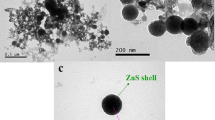Abstract
L-Cysteine capped CdTe nanoparticles (NPs) were synthesized in aqueous medium, and their application as fluorescence probes in the determination of paracetamol was studied. The L-cysteine capped CdTe NPs were characterized by transmission electron microscopy, X-ray diffraction spectrometry, spectrofluorometry, ultraviolet-visible and Fourier transform infrared spectrometry. Based on the distinct fluorescence quenching of CdTe fluorescence probes in the presence of paracetamol, a simple, rapid and specific method for paracetamol determination was presented. Under optimum conditions, the relative fluorescence intensity of CdTe NPs was linearly proportional to paracetamol concentration from 1.0 × 10−8 mol/L to 1.6 × 10−7 mol/L with a detection limit of 4.2 × 10−9 mol/L. The proposed method was applied to detect paracetamol in commercial tablets with satisfactory results.






Similar content being viewed by others
References
Ozcan A, Sahin Y (2011) A novel approach for the determination of paracetamol based on the reduction of N-acetyl-p-benzoquinoneimine formed on the electrochemically treated pencil graphite electrode. Anal Chim Acta 685:9–14
Zhang Y, Luo LQ, Ding YP, Liu XA, Qian ZY (2010) A highly sensitive method for determination of paracetamol by adsorptive stripping voltammetry using a carbon paste electrode modified with nanogold and glutamic acid. Microchim Acta 171:133–138
Babaei A, Garrett DJ, Downard AJ (2011) Selective simultaneous determination of paracetamol and uric acid using a glassy carbon electrode modified with multiwalled carbon nanotube/chitosan composite. Electroanal 23:417–423
Goyal RN, Gupta VK, Chatterjee S (2010) Voltammetric biosensors for the determination of paracetamol at carbon nanotube modified pyrolytic graphite electrode. Sensor Actuat B-Chem 149:252–258
Kalimuthu P, John SA (2010) Selective electrochemical determination of paracetamol using nanostructured film of functionalized thiadiazole modified electrode. Electroanal 22:303–309
Gandhi SV, Ranher SS, Deshpande PB, Shah DK (2011) Simultaneous HPTLC determination of nabumetone and paracetamol in combined tablet dosage form. J Brazil Chem Soc 22:1068–1072
Ravisankar S, Vasudevan M, Gandhimathi M, Suresh B (1998) Reversed-phase HPLC method for the estimation of acetaminophen, ibuprofen and chlorzoxazone in formulations. Talanta 46:1577–1581
Lou HG, Yuan H, Ruan ZR, Jiang B (2010) Simultaneous determination of paracetamol, pseudoephedrine, dextrophan and chlorpheniramine in human plasma by liquid chromatography-tandem mass spectrometry. J Chromatogr B 878:682–688
Hewavitharana AK, Lee S, Dawson PA, Markovich D, Shaw PN (2008) Development of an HPLC-MS/MS method for the selective determination of paracetamol metabolites in mouse urine. Anal Biochem 374:106–111
Zhao SL, Bai WL, Yuan HY, Xiao D (2006) Detection of paracetamol by capillary electrophoresis with chemiluminescence detection. Anal Chim Acta 559:195–199
Lourencao BC, Medeiros RA, Rocha RC, Mazo LH, Fatibello O (2009) Simultaneous voltammetric determination of paracetamol and caffeine in pharmaceutical formulations using a boron-doped diamond electrode. Talanta 78:748–752
Easwaramoorthy D, Yu YC, Huang HJ (2001) Chemiluminescence detection of paracetamol by a luminol-permanganate based reaction. Anal Chim Acta 439:95–100
Sirajuddin AR, Khaskheli A, Shah ML, Bhanger AN, Mahesar S (2007) Simpler spectrophotometric assay of paracetamol in tablets and urine samples. Spectrochim Acta A 68:747–751
Al-Zoubi N, Koundourellis JE, Malamataris S (2002) FT-IR and Raman spectroscopic methods for identification and quantitation of orthorhombic and monoclinic paracetamol in powder mixes. J Pharmaceut Biomed 29:459–467
Kachoosangi RT, Wildgoose GG, Compton RG (2008) Sensitive adsorptive stripping voltammetric determination of paracetamol at multiwalled carbon nanotube modified basal plane pyrolytic graphite electrode. Anal Chim Acta 618:54–60
Li L, Bian RX, Ding YP, Yu ML, Yu DW (2009) Application of functionalized ZnS nanoparticles to determinate uracil and thymine as a fluorescence probe. Mater Chem Phys 113:905–908
Vinayaka AC, Thakur MS (2010) Focus on quantum dots as potential fluorescent probes for monitoring food toxicants and foodborne pathogens. Anal Bioanal Chem 397:1445–1455
Wang GL, Dong YM, Yang HX, Li ZJ (2011) Ultrasensitive cysteine sensing using citrate-capped CdS quantum dots. Talanta 83:943–947
Cao M, Cao C, Liu MG, Wang P, Zhu CQ (2009) Selective fluorometry of cytochrome c using glutathione-capped CdTe quantum dots in weakly basic medium. Microchim Acta 165:341–346
Fei XN, Gu YC, Wang J, Jia GZ, Liu ZJ (2011) Preparation and fluorescent properties of a complex probe based on inorganic QDs and organic dye. J Lumin 131:291–296
Xu H, Miao R, Fang Z, Zhong XH (2011) Quantum dot-based “turn-on” fluorescent probe for detection of zinc and cadmium ions in aqueous media. Anal Chim Acta 687:82–88
Frasco MF, Chaniotakis N (2010) Bioconjugated quantum dots as fluorescent probes for bioanalytical applications. Anal Bioanal Chem 396:229–240
Zhao WF, Fung YS, O W, Cheung MPL (2010) L-cysteine-capped CdTe quantum dots as a fluorescence probe for determination of cardiolipin. Anal Sci 26:879–884
Kuang R, Kuang X, Pan SY, Zheng XD, Duan JC, Duan YQ (2010) Synthesis of cysteamine-coated CdTe quantum dots for the detection of bisphenol A. Microchim Acta 169:109–115
Wang GL, Dong YM, Yang HX, Li ZJ (2011) Ultrasensitive cysteine sensing using citrate-capped CdS quantum dots. Talanta 83:943–947
Priyam A, Chatterjee A, Das SK, Saha A (2005) Synthesis and spectral studies of cysteine-capped CdS nanoparticles. Res Chem Intermed 31:691–702
Li MY, Zhou HM, Zhang HY, Sun P, Yi KY, Wang M, Dong ZZ, Xu SK (2010) Preparation and purification of L-cysteine capped CdTe quantum dots and its self-recovery of degenerate fluorescence. J Lumin 130:1935–1940
Diao XL, Xia YS, Zhang TL, Li Y, Zhu CQ (2007) Fluorescence-detecting cationic surfactants using luminescent CdTe quantum dots as probes. Anal Bioanal Chem 388:1191–1197
Acknowledgements
This research is supported by the National Natural Science Foundation of China (No. 20975066, No. 41140031), the Nano-Foundation of Science and Techniques Commission of Shanghai Municipality (No. 0952nm01500), the Leading Academic Discipline Project of Shanghai Municipal Education Commission (No. J50102), and the Graduate Innovation Foundation of Shanghai University (SHUCX112027).
Author information
Authors and Affiliations
Corresponding author
Rights and permissions
About this article
Cite this article
Li, L., Lu, Y., Ding, Y. et al. Determination of Paracetamol Based on its Quenching Effect on the Photoluminescence of CdTe Fluorescence Probes. J Fluoresc 22, 591–596 (2012). https://doi.org/10.1007/s10895-011-0994-0
Received:
Accepted:
Published:
Issue Date:
DOI: https://doi.org/10.1007/s10895-011-0994-0




